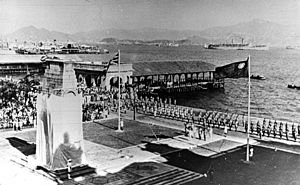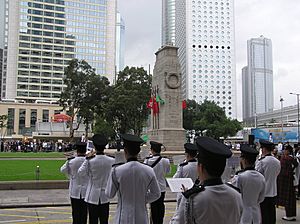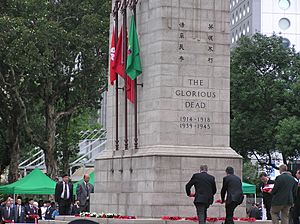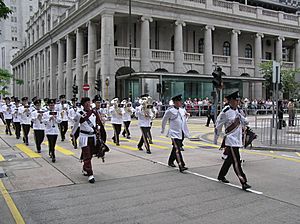The Cenotaph, Hong Kong facts for kids
Quick facts for kids The Cenotaph |
|
|---|---|
| Native name Chinese: 和平紀念碑 |
|
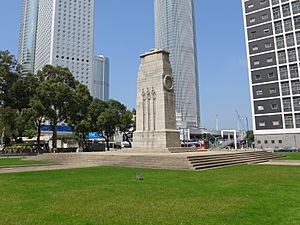
The Cenotaph in February 2014
|
|
| Location | Statue Square |
| Built | 1923 |
|
Declared Monument of Hong Kong
|
|
| Designated | 22 November 2013 |
| Reference no. | 102 |
| The Cenotaph | |||||||||||||||
|---|---|---|---|---|---|---|---|---|---|---|---|---|---|---|---|
| Traditional Chinese | 和平紀念碑 | ||||||||||||||
| Simplified Chinese | 和平纪念碑 | ||||||||||||||
| Literal meaning | Peace Memorial | ||||||||||||||
|
|||||||||||||||
The Cenotaph is a special stone monument in Central, Hong Kong. It stands between Statue Square and the City Hall. This important war memorial was built in 1923. It remembers the brave soldiers from the Royal Navy, British Army, and Royal Air Force who died serving in Hong Kong during the two World Wars.
This monument looks almost exactly like the original Cenotaph in London, UK. That one was designed by Sir Edwin Lutyens. The Hong Kong Cenotaph is now officially recognized as a monument under a special law.
What is the Cenotaph's History?
The Cenotaph was first shown to the public on May 24, 1923. This day was called Empire Day back then. Sir Reginald Edward Stubbs, who was the Governor at the time, officially opened it. When it was built, the area was right by the water!
At first, the monument was made to remember those who died in the First World War. It had the words "The Glorious Dead" carved into it. Later, the dates "1939–1945" were added to honor the people who died in the Second World War. In the 1970s, Chinese words were added too. These words, 英魂不朽 浩氣長存, mean "May their martyred souls be immortal, and their noble spirits endure." They remember those who lost their lives during the Japanese invasion.
On November 22, 2013, the Cenotaph was officially named a monument. This happened under the Antiquities and Monuments Ordinance.
How is the Cenotaph Used for Commemorations?
The Cenotaph is a key place for remembering important historical events. People gather here for special ceremonies.
What is Liberation Day?
During the time when Hong Kong was under British rule, after 1945, there was a special day called Liberation Day. This day was celebrated on the last Monday in August. It remembered when Hong Kong was freed from Japanese occupation in 1945.
Since 1997, official ceremonies for Liberation Day no longer happen here. However, some groups still come to mark the day. Sometimes, the flag poles at the Cenotaph are decorated for these events.
Hong Kong's invasion was part of the Pacific Campaign during World War II. This was different from what was happening on the Chinese mainland. Hong Kong was defended by soldiers from different Commonwealth nations. You can learn more about this in the Battle of Hong Kong article.
What is Remembrance Day?
Remembrance Sunday is a day to remember those who died in wars. In Hong Kong, a special service is held at the Cenotaph. Many different religious groups take part, including Christians, Buddhists, Taoists, Muslims, and Sikhs.
Even though Hong Kong is no longer part of the Commonwealth of Nations since 1997, the service is still very similar to those in other Commonwealth countries. The ceremony includes:
- The playing of "Last Post" (a bugle call).
- Two minutes of quiet silence.
- The playing of "Reveille" (another bugle call).
- People placing wreaths (flower circles) at the monument.
- Prayers.
- A reading of the "Ode of Remembrance".
The Hong Kong Police Force Pipe Band still performs its important role at this service.
What is ANZAC Day?
Every year, on Anzac Day, special events happen in front of the Cenotaph. These events take place early in the morning. The Consuls-General from Australia and New Zealand attend these ceremonies. Before 1997, the High Commissioners from these countries would attend.
What About the Flags at the Cenotaph?
Before 1997, flags were flown at the Cenotaph every day. They were in the same order as the flags at the Cenotaph in London. However, since 1997, flags are only flown during special ceremonies. On Remembrance Day, you can see the flags of Hong Kong, the People's Republic of China, and the Hong Kong Ex-Servicemen's Association.
See also
- Central and Western Heritage Trail
- World War I memorials


